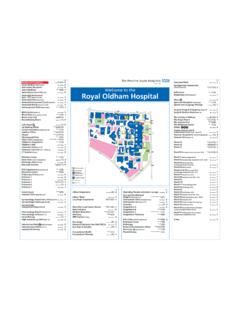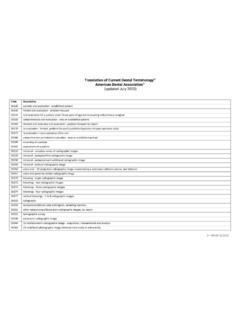Transcription of COVID-19 guidance and standard operating procedure
1 Classification: Official Publications approval reference: 001559 COVID-19 guidance and standard operating procedure For the provision of urgent dental care in primary care dental settings and designated urgent dental care provider sites Version 3 (updated 28 August 2020) This guidance is correct at the time of publishing. However, as it is subject to updates, please use the hyperlinks to confirm the information you are disseminating to the public is accurate. Check if this is the latest version here. Content changes since version 2 (published 4 June 2020) are highlighted in yellow. We appreciate any feedback which could be used to improve this SOP. If you would like to provide feedback please complete this email template.
2 Operational queries regarding this SOP should be directed to your regional commissioning team. 3 Contents 1. Scope .. 4 2. COVID-19 : guidance for local UDC systems and primary dental care providers .. 5 Introduction .. 5 Key principles for local UDC systems .. 7 3. COVID-19 : standard operating procedures for UDC services .. 11 SOP for remote management stage .. 12 Key principles .. 12 SOP for face-to-face management stage .. 17 Key principles .. 17 Appendix 1: Approaches for clinically vulnerable/clinically extremely vulnerable patients .. 23 Appendix 2: Patient pathways .. 24 Appendix 3: PHE guidance for infection prevention and control in dental care settings .. 25 Appendix 4: Actions for dental services.
3 26 Appendix 5: Remote prescribing protocol .. 30 Appendix 6: Preparation for incident management for unwell patients with possible/confirmed COVID-19 .. 32 Appendix 7: Staff support and wellbeing .. 33 4 1. Scope This guidance is applicable in England. Dental services operating under contract to the NHS in Northern Ireland, Scotland and Wales should refer to guidance and standard operating procedures (SOPs) produced by the governing bodies and regulators in their devolved administration. This document covers a local systems approach to the organisation and operation of urgent dental care (UDC) provision. It includes: system-level guidance : of particular relevance to local commissioning teams, local dental networks, local dental committees, managed clinical networks, and local PHE dental public health colleagues standard operating procedures for UDC services (in primary dental care settings and designated UDC provider sites): of particular relevance to dental providers and dental teams.
4 It is appreciated that multiple teams and providers across primary, secondary and social care may be working together as part of local UDC systems. Therefore, this document should be considered alongside other guidance which may be applicable in a particular care context (for example, hospital trust standard operating procedures for COVID-19 should be considered if UDC is delivered as part of secondary care in a hospital setting). It is recognised that communities and health systems vary in size and complexity. This document sets out principles for system development and service delivery which will need local interpretation according to local structures, geography and capacity. We trust healthcare professionals to use their clinical judgement when applying guidance around patient management in what we appreciate is a highly challenging, rapidly changing environment.
5 We are grateful to the following for their support in producing this SOP: Public Health England (PHE), for their advice and support in developing this document The Faculty of Dental surgery at the Royal College of Surgeons, and the Faculty of General Dental Practice (UK), for working with NHS England to develop clinical guidance for dental teams applicable in the COVID-19 context Health Education England Yorkshire & Humber, Imran Suida and Alex Coleman, for producing and sharing a video demonstrating an example of a patient care pathway and practice set up for urgent dental care. 5 2. COVID-19 : guidance for local UDC systems and primary dental care providers Introduction As part of COVID-19 primary care recovery, primary care dental services (general dental practices and community dental services) should now be open for face-to-face care for appropriate patient groups.
6 This includes delivery of both AGP and non-AGP procedures . All care must be delivered in accordance with the infection prevention and control and PPE requirements set out at Appendix 3. While this will re-introduce significant dental activity to local health systems, primary care dental services may still face pandemic related limitations and challenges ( PPE availability, staffing issues). Similarly, the potential for local or national resurgence of COVID-19 may affect dental service delivery. Therefore, there is still a requirement for delivery of robust and safe urgent dental care services through NHS regional urgent dental care (UDC) systems and primary dental care providers. COVID-19 UDC systems and primary dental care providers should deliver: a clear local message for the public, that advises what to do if people have a dental problem, both in and out of hours.
7 Remote consultation and triage that includes: risk assessment and triage of the patient. this may also include advice, analgesia or antimicrobials where appropriate in line with prescribing guidelines (AAA), or the arrangement of a face-to-face consultation and/or treatment by the provider if appropriate or at an appropriate UDC site. This remote stage should specifically identify those patients who are confirmed or suspected COVID-19 cases or household/support bubble contacts, those who are clinically vulnerable, and those who are clinically extremely vulnerable, in order to inform decisions on the most appropriate provider and approach for the delivery of face-to-face care if required. Face-to-face consultation and treatment that should only be provided following the remote risk assessment and triage of the patient.
8 Urgent dental services will be predominantly delivered by general dental practices and community dental services, which should, wherever possible, deliver face-to-face urgent care (non-AGP and AGP where the appropriate PPE is available and subject to capacity) for the appropriate patient groups. All other urgent care (including for patients with possible/confirmed COVID-19 and household/support bubble contacts, when care cannot be delayed) should take place at 6 UDC provider sites designated by local commissioning teams as part of the locally organised system approach. All services must be delivered using the appropriate personal protective equipment (PPE) for the clinical procedures (AGP and/or non-AGP) to be carried out.
9 The local systems and individual providers must ensure that face-to-face assessment and/or treatment is delivered in a way that allows appropriate separation (through physical or temporal measures, zones, sessions/appointment times) and treatment of all patients. The following patient groups should be considered: 1. Patients who are possible or confirmed COVID-19 patients including patients who meet the case definition, or household/support bubble contacts of people with possible or confirmed COVID-19 : These patients should only be seen at designated UDC provider sites. 2. Patients who are clinically extremely vulnerable - those at the highest risk of severe illness from COVID-19 , who may previously have been advised to shield themselves (the government has paused shielding advice from 1 August 2020): Clinically extremely vulnerable patients may be seen for urgent dental care in the same way as other patients.
10 Where possible, without compromising the requirement for access to urgent care in an appropriate timescale, additional efforts should be made to minimise their exposure to risk. Given their risk status, it is particularly important that shared decision-making features in the approach to care for this group, so that care plans can be developed in the patient s best interests. Dental services should take note of care approaches as outlined in Appendix 1. 3. Patients who are clinically vulnerable those at increased risk of severe illness from COVID-19 . 4. Patients who do not fit one of the above categories. Similarly, consideration should be given to the type of urgent dental care to be provided (AGP or non AGP see Appendix 3) which will determine the PPE requirements.












